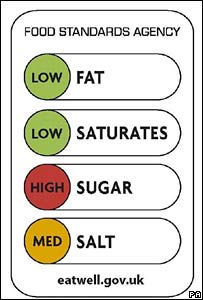UK Food Standards Agency stripped of responsibilities
Britain has, as threatened, split up its Food Standards Agency (roughly equivalent to our FDA). The split only applied to FSA in England. Its role in Scotland, Northern Ireland and Wales remains the same for the moment.
As I mentioned in a previous post, the precipitating cause of the new government’s distress about the FSA was—incredible as it seems—the agency’s support of traffic-light front-of-package labeling.
In its new configuration, FSA keeps its food safety functions. Its nutrition and labeling functions go to the Department of Health. Its country-of-origin and other non-labeling policies go to the Department for Environment, Food and Rural Affairs (Defra).
Surprise! The UK Food and Drink Federation thinks this is a terrific move.
As the voice of the UK food and drink manufacturing sector, we believe it is important to maintain an independent food safety regulator and fully support today’s decision by the Government to retain the Food Standards Agency…We also support the decision to move responsibility for nutrition, and other food policy issues, back into Government departments…This should lead to clearer and more consistent policy making, while avoiding unnecessary duplication of effort across Whitehall.
FSA may be keeping its food safety responsibilities, but Food Safety News reports that the agency hasn’t been doing such a great job with them. FSA’s most recent Annual Report says that it did not achieve its target for reduction of Campylobacter infections. It also failed to reach targets for reductions in salt and saturated fat.
Under the new division of responsibility, salt and fat are no longer FSA’s problem. The Health Department will be dealing with them—or not.
Given the industry-friendly bent of the new new health minister, expect considerable backing off from previous FSA policies.
England is not setting a good example for our FDA, alas.
As for what FDA can and cannot do, see Michael Taylor’s post on the Atlantic Food Channel. In discussing why the FDA isn’t taking a more vigorous enforcement stance against unsubstantiated health claims on food products, Taylor says:
We have no pre-market review authority over such claims, and, under prevailing legal doctrines concerning “commercial free speech,” the evidentiary requirements placed on FDA to prove that such claims are misleading are significant and costly to meet. Moreover, meeting them requires tapping the same team of nutritionists, labeling experts, and lawyers who are working on our other nutrition initiatives.
If they go after health claims, he says, it’s a losing proposition:
We’re also conscious of the cleverness of marketing folks, who, once we prove today’s claim is misleading, can readily come up with another one tomorrow. Going after them one-by-one with the legal and resource restraints we work under is a little like playing Whac-a-Mole, with one hand tied behind your back.
What he doesn’t point out nearly strongly enough, in my opinion, is that doing something about health claims rests with Congress. Congress passes laws. The FDA’s job is to enforce them. Congress needs to give the FDA the tools it needs to protect the public and promote public health.
And that, of course, brings us back to the food safety bill that has been sitting in the Senate for the last 11 months. If Congress can’t even get that passed, it’s hard to be optimistic about its doing anything reasonable about misleading health claims.





 The company’s philosophy: Your toddler won’t drink milk? Try chocolate milk!
The company’s philosophy: Your toddler won’t drink milk? Try chocolate milk!